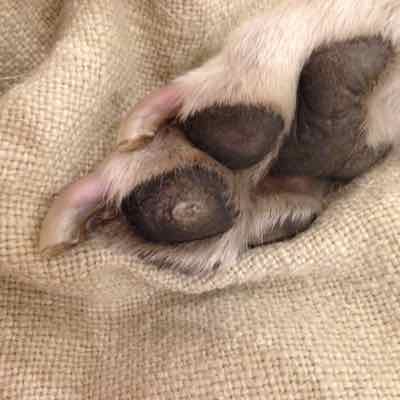Do you have a whippety question? Enter here your query or keyword.
- Home
- Health and Care
- Limping Whippet
Limping Whippet
A limping whippet is a sorry sight. After testing, investigating and spending a small fortune we found the cause of our whippet’s lameness.
Limping Whippet? Check the Paw Pads!
Apparently a very common cause of whippet, greyhounds and lurcher limping are foot pad corns.
Our still young whippet started limping two years ago and at the beginning it was really difficult to pinpoint the sore spot.
Finally I identified the front left leg as the source of the trouble.
We tried to treat my lame dog with anti-inflammatory and cortisone with little or no result.
We started then a battery of tests that went from blood tests, x-rays to echography with no result.
To my annoyance, every time I walked in the streets with my dog, I was pestered with comments of well meaning passersby who suggested remedies, asked why she was limping and offered advice when they were not directly accusing me of neglecting my dog.
My whippet was even given a Reiki session right then and there, in the middle of the street!
Maybe the irritating aspect of this situation was also the fact that at the same time I had developed a tendonitis and I was limping too (we looked like a really sorry couple) but no one ever dreamed of asking me about my lameness, my whippet was the one and only limping diva.
Handling and inspecting my whippet’s paws I could detect a sore toe that appeared to have a spot of hard skin.
It looked like this
I did my research and found out that greyhound and whippets are prone to paw pad corns of mysterious origin but very difficult to eradicate.
Nobody knows if these growth are caused by a dog foot fungus, a virus or are simple corns but they can be extremely painful and sometimes the only solution seems to be cutting out the corn (ouch!) or the amputation of the offended toe (aargh!).
I was determined not to recur to such extreme measures for my dog foot problems.
Thanks to my scientific background I mistrust homeopathy but I use it quite successfully (especially in matters of skin) on my unsuspecting family.
So, my first concern was to go to the nearest pharmacy and invest the respectable sum of three euros in Thuja 30 CH homeopathic globules.
I then ordered thuja cream that is supposed to perform wonders on puzzling skin growths.
After three months, the paw looks clear of corns and my whippet is not limping anymore. Keeping my finger crossed...
Update!
Yes, the cream worked also on a small body growth!
Injury Related Limping
Whippets love to run and they do it with abandon. They sometimes run way faster than it is safe and it seems almost a miracle that they do not incur in more accidents than what they actually do.
Most of the times whippets surprise us by getting up and keep running after what looks like a disastrous fall.
Occasionally they come back limping with a meek expression (yes, they can have a definitely meek expression) offering the injured paw for inspection.
Let's see what to do in case of dog leg injury and when to seek veterinary help.
What to Do if Your Whippet Limps
For a mild lameness, have your dog rest and observe the evolution of the dog leg injury for two or thee days before deciding if it needs medical attention.
Check the whole leg including tips of toes and shoulders. If you find an area that is obviously sore, apply ice packs under supervision (a bag of frozen peas can work miracles but can also be easily ripped open).
Be careful not to freeze the skin with the ice pack. A good rule of thumb is "ten minutes on, ten minutes off".
If your dog limps, is in extreme pain, shows swelling and deformation of a limb or a toe and you ear disquieting sounds when you try to move the affected part, you might suspect a bone fracture or a torn ligament.
Seek immediate veterinary attention and, if possible, immobilize the bone with a rolled magazine taped around the leg.
A peeled foot pad is another common occurrence and can be very painful. Flush the dog paw injury with clean water and oxygen peroxide and restrict exercise for few days until the skin pad is healed.
If the damage is extensive, have a vet examine the dog paw injuries for tendon damage or foreign objects embedded in the wound.
Toe injuries are quite common. You may notice the toe sticking out at an odd angle and your dog may be in obvious pain.
Seek veterinary attention because a stretched ligament may cause the toe to dislocate recurrently and can become a serious problem.
If the toe webbing is split, take your dog to the vet, because these dog paw injuries do not heal on their own and tend to get worse with time.
A dog knee injury can be caused if a whippet gets a leg in a hole or is pushed sideways while running. Your dog will need veterinary help and might need surgery.
Puppies are especially accident prone. They should not be allowed to jump from high places or run to exhaustion because their bones and ligaments are still growing and delicate.
To prevent dog leg injury, don't let your whippets run on slippery surfaces or on too rough ground. Be especially aware of broken glass that can lurk in innocent looking grass.

